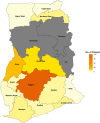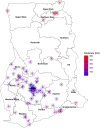Presentation and management of neural tube defects in the middle belt of Ghana
- PMID: 40474002
- PMCID: PMC12141152
- DOI: 10.1007/s00381-025-06869-3
Presentation and management of neural tube defects in the middle belt of Ghana
Abstract
Introduction: Neural tube defects (NTDs) have a high incidence of morbidity and mortality in resource-limited countries. Here, we determine the birth prevalence and describe the presentation, diagnosis, and management of NTDs at Komfo Anokye Teaching Hospital (KATH) in Ghana.
Methods: An ambispective study was conducted for all patients presenting to KATH with NTD from 2019 to 2023. Descriptive statistics and geospatial analysis were completed for relevant clinical data including patient demographics, clinical presentation, surgical details, treatment outcomes, and travel distance.
Results: One hundred seventy-one patients presented with NTDs at a median age of 24 days [IQR 6, 113]. Birth prevalence was 4.7 per 1000 births. The majority of patients presented with myelomeningocele (MM) (79%) followed by encephalocele (16%). Surgical repair was performed for 131 (97%) MM cases at a median age of 33 days [IQR: 18-94 days] and for 25 (93%) encephalocele cases at a median age of 183 days [IQR: 41-384 days]. The median post-operative length of stay was 12 days [IQR 6, 22]. The surgical mortality rate was 7% (11/163). 76 (55%) MM patients developed hydrocephalus, of which 24 (32%) underwent CSF diversion at a median interval of 36 days [IQR 21, 143] following MM repair. Follow-up data were available for 158 (92%) patients, with a median follow-up duration of 16 months (IQR: 4-29 months). At the last follow-up, 70% of patients were alive.
Conclusion: Timely and affordable neurosurgical care remains a challenge for NTD patients at KATH and may contribute to elevated morbidity and mortality.
Keywords: Capacity strengthening; Folate fortification; Low- and middle-income countries; Neural tube defect; Pediatric neurosurgery; Spina bifida.
© 2025. The Author(s).
Conflict of interest statement
Declarations. Competing interests: The authors declare no competing interests.
Figures



References
-
- Harris MJ, Juriloff DM (2007) Mouse mutants with neural tube closure defects and their role in understanding human neural tube defects. Birth Defects Res A 79(3):187–210 - PubMed
MeSH terms
LinkOut - more resources
Full Text Sources
Medical

